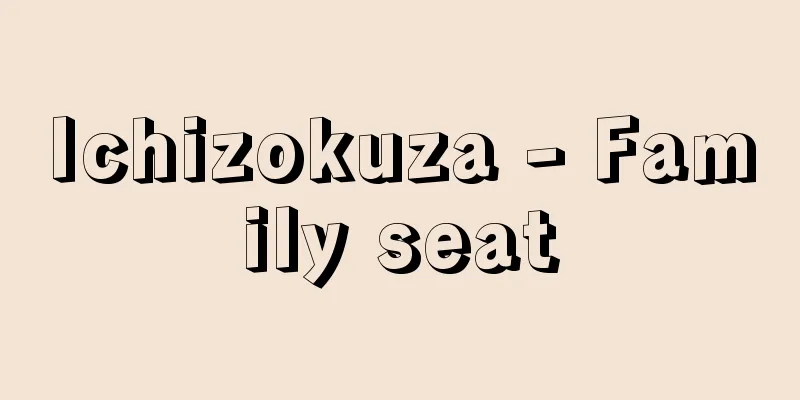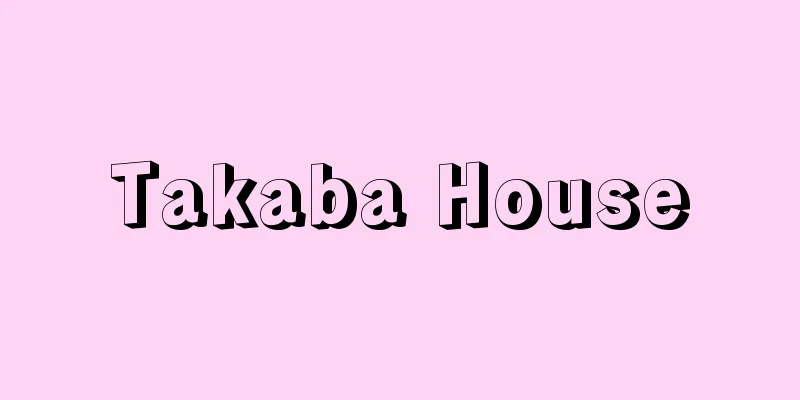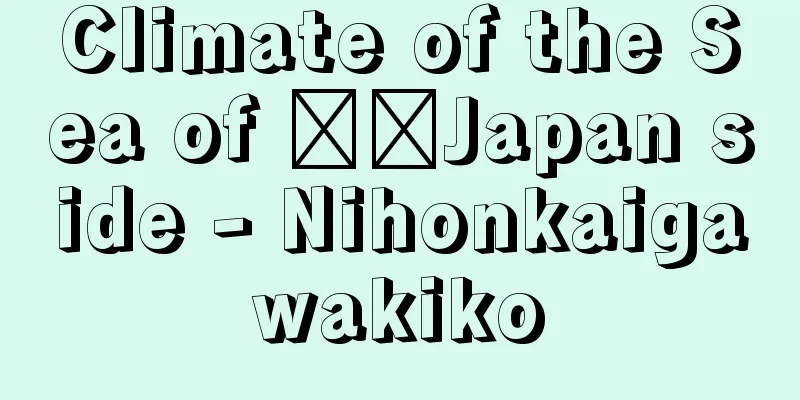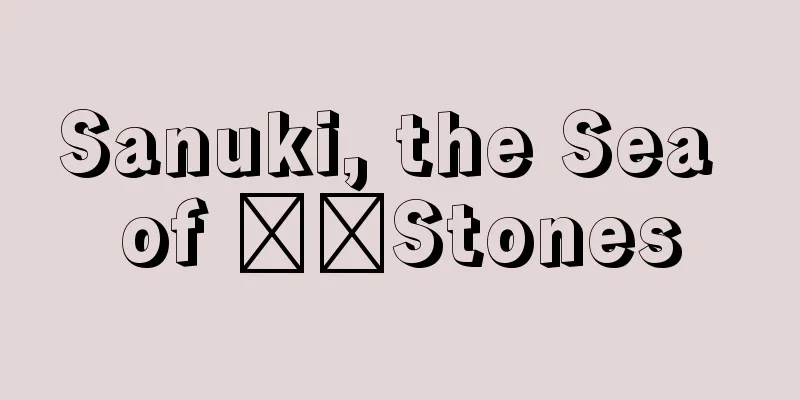Popular song - Ryukouka
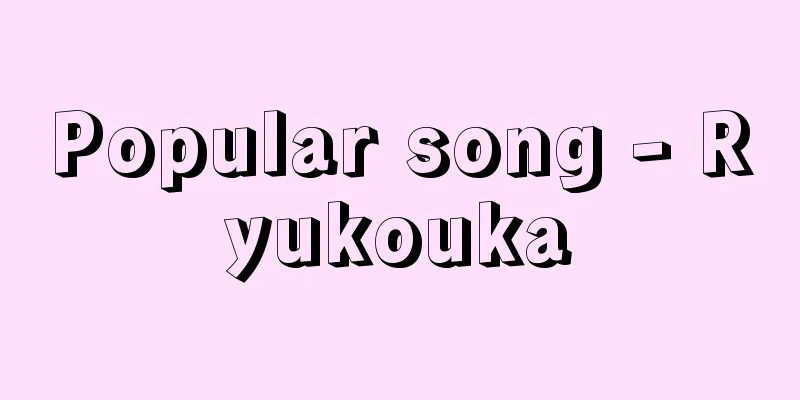
|
A song that was loved by the common people at a certain time. The era and region in which it became popular varies depending on the distribution system for goods, the development of transportation networks, and the penetration of mass media such as movies, records, radio, and television. Note that until the 1910s (mid-Taisho period), it was often written as "popular song" and read as "hayariuta." The word "popular song" began to appear on record labels in 1923 (Taisho 12), and by the 1930s (early Showa period), the term "ryukōka" had become established, but from 1933 (Showa 8), it was also called "kayōkyoku." There are many popular songs from ancient and medieval times, including children's songs from the Nara period, but the most famous popular songs from the red-light districts are "Nagebushi" from Shimabara, Kyoto, "Magakibushi" from Shinmachi, Osaka, and "Tsugibushi" from Yoshiwara, Edo, which became popular from the 1650s (Meireki and Manji). However, it is probably from the 1770s (Meiwa) that the "Okage Mairi no Uta" and "Itakobushi" became widespread. This was followed by "Iyobushi", "Yoshikono", and "Otsuebushi" from the 1840s (Koka and Kaei), and "Hauta" from the 1850s (Ansei), but "Dodoitsu", which became popular around the same time, maintained a long life until the early Showa period. The first big hit song of the Meiji era was "Oppekepe." Kawakami Otojiro began singing it on the stage at Shinkyogoku in Kyoto in 1889 (Meiji 22), and within a few years it had spread nationwide. This song inspired the creation of "Yattsukero-bushi" and "Kimbo-bushi," with "Shin-Shin Negotiations Breakdown" being particularly popular during the Sino-Japanese War. Because these songs were sung in the streets by warrior warriors and students, they were called "soshi-ka" (soldier songs) or "shosei-bushi" (scholarly songs), but before long, "Hokkai-bushi," which uses the moon harp, and "Sanosa" and "Shinonome-bushi," which originated in the entertainment world, became beloved songs all over the country. "Railway Song," "Senyu" and "Rappa-bushi" were also big hits. In the 1910s (Taisho era), Naramaru Kuzushi and Dondonbushi, influenced by Naniwabushi, and from 1914 (Taisho 3), Katyusha no Uta, took the Japanese archipelago by storm. This song caused Matsui Sumako's popularity to soar. After Yalu River Bushi and Iso Bushi, Kare Susuki in 1922 and Kago no Tori in 1924 proved that film was a powerful medium for popular songs. As the Showa era began, more and more movie theme songs were produced, with songs like "Tokyo March" and "The Waitress' Song" becoming big hits. Moreover, these songs became popular in homes thanks to records that had been further improved by electrophonic recording. As a result, three problems arose. The first was an educational problem. It was determined that these songs had a negative impact on character development because young children unconsciously hummed them, and serious consideration was given to ways to prevent this. Next, after 1930 (Showa 5), record sales began to grow dramatically, so record companies placed emphasis on producing popular songs and deepened their inclination toward the music industry. Then, predicting trends, songs that were labeled "popular songs" from the start were released. Previously, songs were called "popular songs" because they were loved by the common people, but their nature changed completely, and the movie industry and record companies became the driving force that influenced the tastes of the common people. Next, partly due to the rise in awareness of copyright, was the emergence of professional songwriters and composers, singers rose to stardom, and new professions were born that had not existed before. Radio, newspapers, and magazines also participated as advertising media for the transformed popular songs. While there were people who admired geisha songs such as "Shima no Musume" (Island Girl) and "Tokyo Ondo" (Tokyo Ondo), voices rejecting them also grew louder. Just as this was happening, "Wasurechaiyayo" became a big hit. Popular songs also began to appear from military songs and radio songs. Films also demonstrated the strength of their theme songs with "Aizen Katsura" and "Dare ka Kokyo wo Omowazaru" (Who Do You Think of Hometown?). The 1930s was when the Japanese style reached a peak. From this time on, the number of fans of foreign music increased, and songs like "Dyna" and "Ame no Blues" began to be sung. This trend became even more pronounced after the Second World War, and songs with various rhythms such as boogie, mambo, and samba were born. Japanese people, who had been limited to melody, began to acquire a rich musicality. The emergence of teenage singers from Misora Hibari to Yamaguchi Momoe and Matsuda Seiko is proof of this. Furthermore, the start of commercial broadcasting in 1951 and television broadcasting in 1953 accelerated the spread of popular songs. Thanks to the appearance of group sounds in 1965 and the folk boom in 1966, the demand for tape recorders skyrocketed, and the light electrical appliance industry continued to do well. However, after the oil crisis in 1973 and the rise of new music, the name "enka" was given to popular songs that had previously been called "kayokyoku." But New Music did not last a decade. After the phenomenal popularity of Pink Lady, Japanese pop music reached a turning point in the 1980s. Coupled with the karaoke boom, record production and broadcast ratings plateaued. Enka in particular fared poorly, with only two songs, "Yagiri no Watashi" and "Inochi Kurenai," selling more than one million copies at the time. Furthermore, the annual NHK end-of-year show, "Kohaku Uta Gassen," had secured viewer ratings of over 80% in the 1960s and 1970s, but since 1986 it has languished at around 50%. In the past, popular songs reflected the lives of ordinary people and often contained lyrics expressing "tears" or "sadness," but around the time of the period of rapid economic growth, the themes changed to "love" and "romance." Then, as mass production and mass consumption continued, the 1990s arrived and the situation changed completely. Million-sellers began to appear one after another on compact discs, and popular songs became powerful voices that celebrated the lives of the younger generation. New music also incorporated rock and jazz. It is so closely linked to the lives of young people that they are even whispered about as "musical people." Of course, with tastes diversifying and earphones becoming more widespread, it is difficult to grasp the true nature of trends, but as if in inverse proportion to the decline of karaoke, the transformed popular songs will likely gain support from the younger generation. [Yoshihiro Kurata] Sonobe Saburo, Yazawa Tamotsu and others, "Japanese Popular Songs: Their Appeal and the Mechanism of Popularity" (1980, Otsuki Shoten) ▽ Shindo Ken, "Japanese Popular Singers: From Shoji Taro to Pink Lady" (1979, Sanichi Shobo) ▽ Soeda Tomomichi, "Popular Songs from the Meiji and Taisho Eras" (1982, Tosui Shobo) ▽ Takahashi Keiichi Collected Works 10: Modern Japanese History Written through Popular Songs (1985, Ayumi Publishing) ▽ Komoda Nobuo et al. (eds.), "New Edition: History of Japanese Popular Songs, Vols. 1, 2 and 3" (1994-95, Shakai Shisosha) [References] | | | | | | | | | |Han | | |Source: Shogakukan Encyclopedia Nipponica About Encyclopedia Nipponica Information | Legend |
|
ある時期に庶民が愛好した歌曲。流行した時代や地域は、商品の流通機構、交通網の発達、映画、レコード、ラジオ、テレビジョンなどマスメディアの浸透状況によって異なる。なお、1910年代(大正中期)までは「流行唄」と表記されることが多く、「はやりうた」と読まれていた。「流行歌」の文字がレコードのレーベルに現れるのは1923年(大正12)、そして1930年代(昭和初期)には「りゅうこうか」という呼称が定着するが、1933年(昭和8)から「歌謡曲」ともいわれた。 奈良時代の童謡(わざうた)をはじめ、古代や中世の流行唄(はやりうた)は数多く残っているが、色里町中(いろざとまちじゅう)はやり歌として著名なものは、1650年代(明暦・万治)から流行した京都・島原の「投(なげ)ぶし」、大坂・新町の「籬(まがき)ぶし」、江戸・吉原の「つぎぶし」である。しかし広範囲に及ぶのは、1770年代(明和)の「おかげまいりの歌」や「潮来(いたこ)節」からであろう。1840年代(弘化・嘉永)の「伊予(いよ)節」「よしこの」「大津絵節」、1850年代(安政)以降の端唄(はうた)などがこれに続くが、同時期から流行し始めた「都々逸」(どどいつ)は、昭和初期まで長い生命を保った。 明治における最初の大流行歌は、『オッペケペー』である。1889年(明治22)川上音二郎が京都・新京極の高座で歌いだし、数年を経ずして全国に広まった。この曲に刺激されて生まれたのが『ヤッツケロ節』や『欽慕(きんぼ)節』で、とりわけ日清(にっしん)戦争の最中には「日清談判破裂して」がもてはやされた。こうした歌を街頭で歌ったのが壮士や書生であったから、「壮士歌」とか「書生節」とよばれたが、やがて月琴(げっきん)を用いた『法界節』や、花柳界からおこった『さのさ』『東雲(しののめ)節』が全国で愛唱される。『鉄道唱歌』『戦友』『ラッパ節』も大流行。1910年代(大正)になると、浪花節(なにわぶし)の影響を受けた『奈良丸(ならまる)くずし』『どんどん節』が、そして1914年(大正3)から『カチューシャの唄』が日本列島を風靡(ふうび)する。この歌によって、松井須磨子(まついすまこ)の人気は急上昇した。『鴨緑江(おうりょくこう)節』や『磯(いそ)節』のあと、1922年の『枯れすすき』と1924年の『籠(かご)の鳥』によって、映画が流行歌の強力な媒体となることが証明された。 映画主題歌は昭和になるとともにいっそう多く製作され、『東京行進曲』や『女給の唄』が大きな話題となる。しかもこれらの歌は、電気吹き込みで音色が一段と改良されたレコードにより、家庭内に浸透した。その結果、三つの問題が派生してくる。第一は教育問題である。幼い子供たちが無意識に口ずさむため、人間形成に悪影響を与えるときめつけられ、その防止策が真剣に検討された。次に、1930年(昭和5)を境としてレコードの売上げは飛躍的に伸びだしたので、レコード・メーカーは流行歌の製作に重点を置き、音楽産業への傾斜を深めていく。そして、流行を予測し、最初から「流行歌」と銘打った曲が発売される。従来は庶民が愛好したので「流行歌」となったが、その性格は一変し、映画産業とレコード企業が庶民の嗜好(しこう)を左右する原動力となる。その次は、著作権意識の高揚とも絡むが、作詞や作曲の専業者が現れ、歌手がスターの座につくようになり、従来にない新しい職業が誕生したことである。さま変わりした流行歌の宣伝媒体として、ラジオや新聞、雑誌も参加してくる。『島の娘』や『東京音頭(おんど)』などの芸者唄にあこがれる者が現れる反面、それを拒否する声も大きくなった。その矢先に、『忘れちゃいやヨ』が大ヒットした。軍歌やラジオ歌謡からも流行曲が現れてくる。また映画は、『愛染かつら』や『誰(たれ)か故郷を想(おも)はざる』によって、主題歌の強さを誇示した。1930年代は、日本調が一つの頂点に達したときである。 このころから外国楽曲の愛好者が増え、『ダイナ』や『雨のブルース』が歌われる。この流れは第二次世界大戦後になってますます顕著となり、ブギ、マンボ、サンバなど、さまざまなリズムの曲が生まれてくる。メロディーに終始していた日本人が、豊かな音楽性を身につけ始めた。美空ひばりから山口百恵(やまぐちももえ)や松田聖子(まつだせいこ)に至る十代歌手の出現は、その実証となろう。さらに1951年(昭和26)から始まった民間放送や、1953年に放送が開始されたテレビジョンは、流行歌の普及に拍車をかけた。1965年のグループ・サウンズの登場、1966年のフォーク・ブームなども幸いし、テープ・レコーダーの需要はうなぎ上りとなり、弱電産業は好業績を続ける。が、1973年の石油ショック以後にニューミュージックが台頭してからというもの、それまで「歌謡曲」とよばれていた流行歌に、「演歌」という名称が与えられるようになった。しかしニューミュージックも10年とは続かなかった。ピンク・レディーの驚異的な流行を最後に、日本の流行歌は1980年代には曲がり角にさしかかった。カラオケ・ブームとも相まって、レコードの生産枚数や放送の視聴率は頭打ちとなった。とくに演歌は不振で、当時のレコード売上げで100万枚を超えたのは『矢切の渡し』と『命くれない』のわずか2曲にすぎなかった。また、年末恒例のNHK「紅白歌合戦」では、1960~1970年代に80%を上回る視聴率を確保していたものが、1986年以降は50%前後と低迷している。 かつて流行歌は庶民の生活を反映し、「涙」とか「悲しい」という歌詞を多用してきたが、高度成長のころからテーマは「愛」や「恋」に変わった。そして大量生産、大量消費を繰り返しているうちに、1990年代を迎え、様相は一変する。CD(コンパクトディスク)ではミリオンセラーが続出しはじめ、流行歌は若い世代の生を謳歌(おうか)する力強い歌声になった。ニューミュージックはロックやジャズをも取り込む。若者の生活と強く結び付き、「音楽人間」とささやかれるほどである。もっとも、嗜好の多様化や、イヤホンの普及によって流行の実態は把握しにくいが、カラオケの凋落(ちょうらく)と反比例するかのように、変質した流行歌は若い世代の支持を得ていくであろう。 [倉田喜弘] 『園部三郎・矢沢保他著『日本の流行歌――その魅力と流行のしくみ』(1980・大月書店)』▽『新藤謙著『日本の流行歌手――東海林太郎からピンクレディまで』(1979・三一書房)』▽『添田知道著『流行歌明治大正史』(1982・刀水書房)』▽『『高橋磌一著作集10 流行歌でつづる日本現代史』(1985・あゆみ出版)』▽『古茂田信男他編『新版 日本流行歌史』上中下(1994~95・社会思想社)』 [参照項目] | | | | | | | | | | | | |出典 小学館 日本大百科全書(ニッポニカ)日本大百科全書(ニッポニカ)について 情報 | 凡例 |
>>: Haya Monogatari - Haya Monogatari
Recommend
Box shrimp (Linuparus trigonus)
A decapod crustacean of the family Spinyridae (ill...
Matsu Kanshi
Year of death: May 25, 1798 (July 8, 1798) Year of...
Kimberley Block
…the Kimberley Block is a general term for the mo...
Chikusichloa aquafica Koidz.
It is a perennial grass of the Poaceae family that...
Sukashikashipan - Sukashikashipan
A marine animal belonging to the phylum Echinoder...
Devil Lizard - Akuma tokage
... As a result of adapting to and dispersing int...
Oninishi - Oni Nishi
...The meat is eaten, the shells are used to make...
Tenrikyo Rebellion
In 1813, during the Qing Dynasty in China, a reli...
Olive Clona
1897‐1980 Swedish legal philosopher, procedural sc...
Pyrrhocoridae - Pyrrhocoridae
...General term for insects of the Hemiptera fami...
Akatachi (English spelling) bandfishes
A general term for marine fishes belonging to the...
Noushi
A type of robe worn by nobles (kuge). It means st...
Oradour‐sur‐Glane
A town in the Haute-Bienne department in central F...
Kamiyahagi [town] - Kamiyahagi
A former town in Ena County, in the southeastern t...
Cutting blade
〘 noun 〙① A blade that cuts things well. A blade t...

